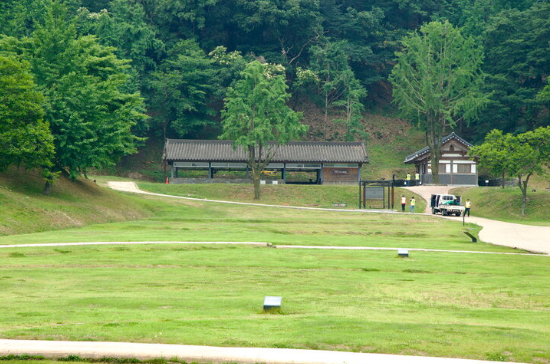Table of Contents
What Are Ground Maintenance Contracts?
Ground maintenance contracts establish formal agreements between service providers and property owners for the ongoing care of outdoor spaces. These legally binding documents outline specific services, costs, and timelines for maintaining everything from lawns and landscapes to sports fields and cemeteries.
Definition and Purpose
Ground maintenance contracts outline the scope, terms, and conditions for ongoing care of outdoor spaces. Service providers and property owners or organisations use these contracts to formalise their professional relationship.
The primary purpose of these contracts is to ensure consistent, high-quality maintenance of outdoor areas while clearly defining responsibilities, expectations, and payment terms. Property owners gain peace of mind knowing their grounds will receive regular attention without managing daily operations.
Contractors secure steady work and income streams, often spanning multiple years. Well-crafted contracts protect both parties by specifying exactly what services will be provided, when they’ll be performed, and how much they’ll cost.
Common Contract Types
Ground maintenance contracts typically fall into several categories based on service frequency, scope, and duration. Annual contracts provide year-round coverage with services adjusted seasonally, offering stability for both parties.
These often include core services like mowing and hedge trimming with additional seasonal work. Performance-based contracts focus on outcomes rather than specific tasks, giving contractors flexibility in how they achieve agreed-upon standards.
The client pays for results rather than individual services. Fixed-price contracts specify a set fee for defined services, protecting you from unexpected cost increases.
Alternatively, time and materials contracts bill based on actual work performed and materials used, offering flexibility for variable needs. Public sector contracts often take the form of framework agreements that establish qualified supplier lists for grounds maintenance services.
These typically run for 3-4 years and may cover diverse services including:
Soft landscaping
Sports facility maintenance
Snow and ice removal
Tree care and pruning
Key Stakeholders
Ground maintenance contracts involve multiple stakeholders with distinct roles and interests. Property owners or facility managers act as primary clients seeking reliable maintenance services for their grounds.
They focus on maintaining property values, ensuring safety, and creating attractive environments. Service providers range from individual contractors to large maintenance companies.
These professionals deliver the actual maintenance work and must balance quality service with operational efficiency and profitability. They often specialise in particular types of grounds work.
Public sector organisations like local authorities, housing associations, and universities frequently tender ground maintenance contracts. These bodies must ensure fair procurement processes and value for taxpayer money.
End users—the people who use the maintained spaces—are important stakeholders whose satisfaction often determines contract success. Whether they’re residents, employees, students, or the general public, their experience of well-maintained grounds is the ultimate measure of contract effectiveness.
Core Components of Grounds Maintenance Contracts
Effective grounds maintenance contracts require clear structure and detailed specifications to ensure all parties understand their responsibilities. Well-drafted contracts establish expectations, streamline management, and prevent disputes between service providers and clients.
Service Specifications
Service specifications form the foundation of grounds maintenance contracts. These detailed descriptions outline exactly what work will be performed, where, and how often.
Your contract should clearly identify all areas requiring maintenance and list specific tasks such as grass cutting, hedge trimming, weed control, and seasonal plantings. The specification should include site maps and measurements of all areas to be maintained.
This precision helps contractors accurately price their services and prevents misunderstandings about scope. Be specific about seasonal requirements, as maintenance needs vary throughout the year.
For example, specify grass cutting frequency during growing seasons versus dormant periods. Equipment requirements should be detailed, including any specifications about machinery that must be used for particular tasks.
Some contracts also include provisions for pesticide applications, detailing approved chemicals and application methods.
Performance Standards
Performance standards establish the quality benchmarks contractors must meet. Rather than simply listing tasks, your contract should define what “good” looks like for each service component.
For instance, specify the acceptable grass height range after cutting or the visual standard for hedge trimming. Include clear metrics for measuring performance, such as response times for addressing issues and rectification periods for substandard work.
These objective standards make monitoring and enforcement more straightforward. Consider incorporating a monitoring framework with regular inspections and reporting requirements.
This might include photographic evidence of completed work or scheduled joint inspections. Define consequences for failing to meet standards, whether through financial penalties, remediation requirements, or contract termination clauses.
Contract Duration and Renewal
Determining the optimal length for your grounds maintenance contract requires balancing stability against flexibility. Typical contracts run for 2-5 years, with options for extension based on performance.
Include clear terms for contract renewal, with specific timelines for review and notification of intent to extend or terminate. This provides certainty for both parties and allows for planning.
Build in provisions for price adjustments during the contract period, especially for multi-year agreements. These might be linked to inflation indices or scheduled reviews at specific intervals.
Your contract should also outline the circumstances under which either party can terminate the agreement early. Include notice periods and processes for handover to ensure continuity of service if the contract ends.

Types of Grounds Maintenance Services Delivered
Grounds maintenance services encompass a wide range of activities designed to keep outdoor spaces functional, safe, and visually appealing. These services can be delivered year-round or seasonally depending on specific site requirements and climate conditions.
Routine Grass and Lawn Care
Grass cutting forms the cornerstone of most grounds maintenance contracts. This includes regular mowing at appropriate heights according to season and grass type.
Frequency typically ranges from weekly cuts during peak growing seasons to monthly maintenance during dormant periods. Lawn care services also encompass fertilisation programmes, which should be tailored to soil conditions and grass species.
Professional grounds maintenance teams apply treatments at optimal times to encourage healthy growth whilst minimising environmental impact. Weed control is another crucial element, using either traditional or non-traditional treatments.
Many contracts now specify reduced chemical usage, focusing instead on cultural practices and selective herbicide application. Sports pitch maintenance may also feature, including specialised mowing patterns, aeration, and line marking.
These services require specific equipment and expertise to maintain playable, safe surfaces that meet sporting regulations.
Hedge and Shrub Maintenance
Professional hedge maintenance includes regular trimming to maintain shape, height, and width. This service prevents encroachment onto pathways and maintains clear sightlines for safety purposes.
Shrub bed maintenance encompasses pruning, weeding, and mulching. Skilled contractors understand different pruning requirements for various plant species, ensuring cuts are made at appropriate times to encourage flowering and healthy growth.
Planting services may also be included, with seasonal bedding schemes or permanent plantings. Good contracts specify plant quality standards, establishment periods, and replacement requirements for failed specimens.
Mulching is often provided to suppress weeds, retain soil moisture, and improve aesthetics. Contractors should use appropriate materials that enhance soil structure whilst complementing the landscape design.
Tree Works and Emergency Call-Outs
Tree maintenance services include crown raising, crown thinning, and deadwood removal. Qualified arborists carry out these operations with an understanding of tree biology and safe working practices.
Emergency call-out provisions are essential for handling fallen branches or storm-damaged trees. Contracts should clearly specify response times and risk assessment procedures.
Tree planting and aftercare may be included to benefit ground structure and enhance biodiversity. This includes stake installation, watering schedules, and formative pruning during establishment periods.
Tree inspections form a vital part of grounds maintenance contracts, identifying potential hazards before they become dangerous. Regular surveys by qualified personnel help fulfil duty of care obligations and maintain a safe environment.
Site Cleansing and Litter Removal
Litter picking and bin emptying services maintain site cleanliness and prevent vermin issues. Frequency should be specified based on usage patterns and visitor numbers.
Hard surface maintenance includes sweeping paths, pressure washing, and weed control. These services prevent slip hazards and maintain accessibility for all site users.
Removal of fallen leaves is particularly important in autumn to prevent slippery surfaces and blocked drainage systems. Contracts should specify collection methods and disposal arrangements.
Gritting paths and car parks during winter months helps maintain safe access. Grounds maintenance contracts should detail trigger temperatures, priority areas, and response times to ensure effective service delivery.

Tendering and Procurement for Grounds Maintenance Contracts
Securing grounds maintenance contracts requires understanding the tendering landscape and procurement requirements. The UK public sector offers numerous opportunities for service providers, with contracts typically covering activities like grass cutting, landscaping, and tree surgery.
Grounds Maintenance Tenders Explained
Grounds maintenance tenders are formal invitations for service providers to bid on contracts related to the upkeep and management of outdoor spaces. These tenders can be found through various platforms including Complete Tenders directory, Contracts Finder, Public Contracts Scotland, and Sell 2 Wales.
Tenders may be categorised into specific service areas such as arboricultural services, gardens maintenance, cemetery renovation, and general grounds work services. The UK public sector regularly issues these opportunities, with contracts varying in size, duration, and complexity.
Grounds maintenance contracts are often divided by geographical regions, as seen in the Essex example where separate contracts cover North and South regions. This regional approach allows for more manageable service delivery and creates opportunities for both large companies and smaller local providers.
The Tendering Process
The tendering process typically begins with identifying relevant opportunities through tender platforms and directories. You must carefully review the tender documentation to understand the scope, requirements, and evaluation criteria.
Most grounds maintenance tenders require:
Company information and financial stability evidence
Relevant experience and track record
Health and safety policies
Environmental management systems
Staff qualifications and training
Equipment and resources details
Methodology statements
Contract values can range significantly, as evidenced by the BGG Garden and Tree Care Ltd contract worth £51,517.98 (excluding VAT) signed in March 2025 for a two-year period. The procurement process typically categorises these under “Services” and uses specific CPV classifications.
Evaluation Criteria
When evaluating grounds maintenance tenders, procurement teams assess bids using a combination of quality and price factors. Understanding these criteria is crucial for crafting compelling proposals.
Common evaluation criteria include:
Price competitiveness (often 40-60% of total score)
Technical competence and methodology
Experience with similar contracts
Environmental sustainability practices
Social value contributions
Quality management systems
Your tender response should directly address each criterion with specific examples rather than general statements. Provide evidence of your capability through case studies, testimonials, and performance metrics from previous contracts.
For construction-related grounds maintenance, additional considerations may include site management plans and adherence to building regulations. Demonstrating knowledge of seasonal requirements and showing flexibility in service delivery can significantly strengthen your bid in this competitive sector.

Regional Considerations: Case Study of the East of England
The East of England presents unique opportunities and challenges for grounds maintenance contracts, with distinctive procurement patterns and a competitive supplier landscape. Recent data shows significant activity in this region with over 650 grounds maintenance contracts awarded in the past year.
Market Overview
The East of England grounds maintenance sector demonstrates robust activity with hundreds of contracts being tendered annually. Highways England recently appointed Ringway as its contractor for the new Maintenance and Response contract for the East Region in a significant deal worth £420 million.
This 15-year asset delivery contract, valued at approximately £28 million annually, focuses on maintaining Highways England’s strategic network in the region. The contract represents one of the larger investments in the area’s infrastructure maintenance.
Local authorities throughout the region regularly issue tenders for grounds maintenance services including arboricultural work, garden upkeep, and cemetery renovation projects. These contracts vary in size and scope, providing diverse opportunities for service providers in the market.
Local Authority Approaches
East of England local councils typically structure their grounds maintenance tenders through framework agreements, allowing for both efficiency and flexibility. Many utilise the official Contracts Finder platform to advertise opportunities and ensure compliance with procurement regulations.
The Central Purchasing Consortium (CPC) offers a specialised Grounds Maintenance Services framework with a dedicated lot (Lot 6) specifically for the East of England. This framework enables public sector buyers to engage with pre-approved suppliers.
Contracts often include multiple service elements beyond basic grass cutting—incorporating hedge trimming, weed control, and seasonal planting. Councils are increasingly incorporating sustainability requirements into tender specifications, emphasising reduced environmental impact and biodiversity enhancement.
Opportunities for SMEs
Smaller maintenance companies can successfully compete for grounds maintenance tenders in the East of England through several strategic approaches. Sub-contracting relationships with larger framework holders presents one viable path to market entry.
You can access smaller-value contracts directly through local authority websites and the Contracts Finder portal, where opportunities under certain thresholds may have simplified procurement processes. The Complete Tenders directory regularly updates with regional grounds maintenance opportunities suitable for SMEs.
The CPC framework explicitly mentions that suppliers may “self-deliver or sub-contract” core maintenance services, creating openings for specialist SMEs. Building a portfolio of successful smaller contracts can position your company to compete for larger opportunities as you establish a regional reputation for quality service delivery.

Legal and Compliance Aspects
Navigating the legal landscape is crucial when establishing grounds maintenance contracts. Compliance with current regulations protects your business and ensures safety, environmental responsibility, and clear contractual relationships.
Health and Safety Regulations
The Construction (Design and Management) Regulations 2015 directly impact grounds maintenance operations across the UK. You must ensure that all maintenance activities adhere to these regulations to maintain a safe working environment for your staff and the public.
Conduct risk assessments before undertaking any grounds maintenance work. Identify potential hazards such as working at heights, operating machinery, or handling chemicals.
Clearly outline Personal Protective Equipment (PPE) requirements in your contracts. Enforce these requirements during all operations, including safety boots, gloves, eye protection, and appropriate clothing.
Maintain and regularly update staff training records to demonstrate compliance. Ensure all workers are properly qualified for their specific tasks, especially when operating specialised equipment or applying treatments.
Carry out regular safety audits. Document these inspections thoroughly, as regulators may request them during reviews.
Environmental Requirements
Environmental compliance has become increasingly important for grounds maintenance contracts. You must be aware of local by-laws and planning permissions that might affect maintenance activities, particularly in sensitive areas or protected landscapes.
Pay special attention to waste disposal regulations. Dispose of all green waste and other materials according to current environmental guidelines, and maintain proper documentation.
Strictly regulate chemical usage. Properly certified operatives must apply pesticides, herbicides, and fertilisers using approved methods. Keep meticulous records of application dates, quantities, and locations.
Include water conservation measures in your maintenance plans. Install efficient irrigation systems or select drought-resistant plants where appropriate.
Incorporate biodiversity considerations into your maintenance strategies. Preserve habitat areas, install wildlife-friendly features, or adopt mowing regimes that encourage wildflowers.
Contractual Obligations
Clear, comprehensive contracts are essential for grounds maintenance services. Specify performance outputs rather than simply listing inputs, focusing on standards and suitability for purpose.
Explicitly state duration and extension terms. Many grounds maintenance contracts last several years with possibilities for extension based on performance metrics.
Make payment terms and schedules unambiguous. Include details about how additional work outside the standard scope will be charged and authorised.
Service level agreements (SLAs) establish clear expectations for both parties. Include response times for emergencies, quality standards, and frequency of routine maintenance activities.
Clearly state liability and insurance requirements in your contracts. Specify who is responsible for damages during maintenance activities and what insurance coverage is required.
Build regular performance reviews into your contracts. This allows for adjustments if needed and helps maintain positive client relationships.

Managing and Monitoring Contract Performance
Effective management of grounds maintenance contracts requires systematic oversight and clear communication channels. Regular monitoring ensures service providers meet agreed standards and deliver value for money across all maintenance activities.
Account Management
Establish a dedicated account management structure for grounds maintenance contracts. Appoint a contract manager as the primary point of contact between your organisation and the maintenance provider.
This contract manager handles day-to-day communications and resolves issues promptly. Create a clear escalation pathway for when problems arise to ensure matters reach senior management without delays in service delivery.
Document all communications and decisions in a centralised system. This audit trail proves invaluable when reviewing contract performance or negotiating renewals.
Hold regular account management meetings, either monthly or quarterly, to maintain alignment between your expectations and the provider’s delivery. Use a structured agenda that includes recent performance data and upcoming maintenance requirements.
Quality and Customer Experience
Quality control is fundamental to grounds maintenance services. Establish clear, measurable quality standards in your contract specifications, covering all aspects of maintenance work from grass cutting heights to planting schedules.
Implement a robust inspection regime with both scheduled and surprise site visits. Include photographic evidence of completed work as part of your quality assurance process.
Use customer satisfaction surveys to gather feedback from users of the maintained spaces. This provides valuable insight into how the grounds maintenance services are perceived by those who experience them daily.
Create a simple reporting mechanism for users to flag immediate issues such as fallen trees or dangerous conditions. Respond quickly to these reports to demonstrate the effectiveness of your management system.
Clearly define training requirements for maintenance staff in your contract. Ensure all personnel have appropriate skills and knowledge.
Performance Review Methods
Develop a comprehensive set of Key Performance Indicators (KPIs) that align with your grounds maintenance objectives. These might include response times, completion rates, and quality scores from inspections.
Hold quarterly performance review meetings to analyse data against these KPIs. Use visual dashboards and trend analysis to identify patterns in service delivery.
Example KPI Framework:
Timeliness: % of scheduled maintenance completed on time
Quality: Inspection scores (1-10) for completed work
Environmental: Compliance with sustainable practices
Customer: Satisfaction ratings from user feedback
Implement a balanced scorecard approach that considers both quantitative metrics and qualitative assessments. This provides a holistic view of contractor performance.
Consider performance-based incentives where appropriate. Financial bonuses for exceeding targets can motivate your grounds maintenance provider to deliver exceptional service.
